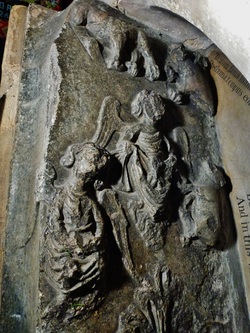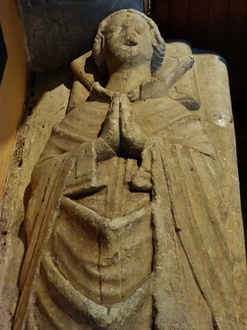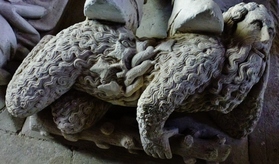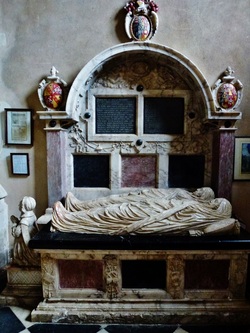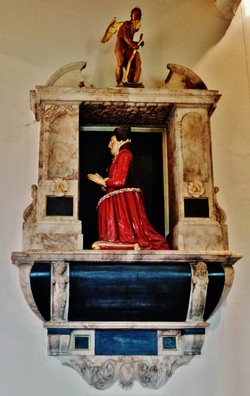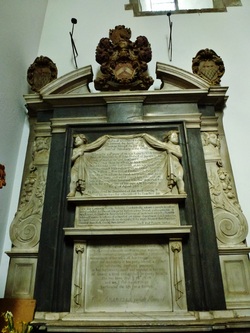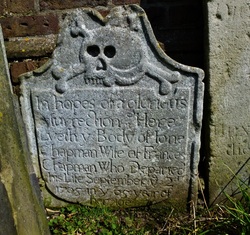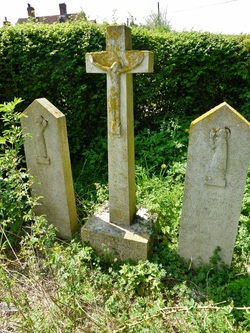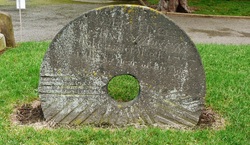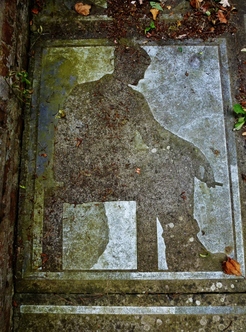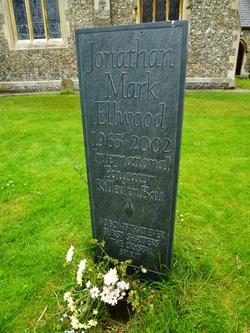Two of the earliest monuments in Hertfordshire are those of Thirteenth century knights wearing mail, reflecting the power of that class within society. At both Walkern and Eastwick they are workshop effigies, probably made in London from imported Purbeck marble. They both have crossed legs (a fashion of the latter part of the century, and nothing to do with the crusades) and both hold long shields whilst drawing their swords. That at Eastwick has the deeper carving whilst that at Walkern wears a pot helm covering his face. There is also a memorial at Brent Pelham, also carved in Purbeck marble but with a range of iconography rare for the time. This is an ornate version of the more common cross slabs that were often coffin lids, but is carved with an angel carrying a soul up to heaven and the symbols of the evangelists, as well as an ornate cross with its shaft piercing a dragon. This rarity is likely to be the tomb of a priest, though myths grew up later of a local dragon killer, Piers Shonks, a giant whose burial in the wall was to fool the devil.
By the end of the century the niches in which such effigies normally rested had become more ornate, with gabled canopy and pinnacles. A battered example remains at Anstey, complete with a civilian effigy. Only the richest of merchants could afford such at that time, and well into the next century only knights or priests had any form of memorial within the church. The crosses stone roundels on that marked graves outside have rarely survived, and most people probably made do with simple wooden crosses. During the fourteenth century, chest tombs appear, and Purbeck marble gives way to stone and even alabaster for effigies. Wives appear beside their armoured husbands at Benington and Little Munden, and women alone in the canopied tombs at Aldenham. Heraldry comes to play a big part in tombs, nowhere more than on that of Prince Edmund of Kings Langley. The fifteenth century sees a change to engraved brass memorials, when the merchants rich on cloth and wool were able to aspire to memorials of their own, cheaper to make and mass produced in London. Local masons still carved tombs in situ, though by now being shown in armour was rather an affectation than a claim to military prowess. In the sixteenth century great lords from court bought country estates within the county, and such was the importance of a landed estate that English lords preferred to be buried in their own local church, especially after the Reformation had destroyed or recycled all of those tombs that were in monastic churches. At the beginning of the century mass produced canopy tombs of Purbeck marble appear, as at Broxbourne and Sawbridgeworth, carrying not effigies but brasses; later the alabastermen of Burton on Trent tried to compete with Flemings by including classical details as on the Brocket tomb at Wheathampstead.
Many a self made man proclaimed his family’s glory by having an expensive memorial constructed during his own lifetime, or specified in his will. The most fabulous were made in the early seventeenth century workshop at Southwark, including those tombs at Watford, Standon and Hertingfordbury, colourful classical canopies of alabaster and touch with realistically carved recumbent figures all aglitter with gold. The most unusual is that to Lord Cecil at Hatfield, with its black marble slab carried by four full sized virtues, with a skeleton beneath and the Chancellor on top. Another unusual memorial is that of the seated Lord Bacon at St. Albans. Cheaper tombs showed smaller figures kneeling at prayer, and a fashion for showing the dead arising in shrouds appeared. After the Civil War, tombs became more sombre, with heraldic ledgers on the floor, only to blossom again in the baroque eighteenth century, when full size marble figures strut and preen, or loll and talk on tombs proclaiming them to be the source of all virtues, as at Abbots Langley and Knebworth. Graveyard memorials become more sculptural too, with tombstones gaining an iconography of their own. In the early nineteenth century Grecian figurative plaques appear inside, as at Wheathampstead and Great Amwell, becoming increasingly pious until the Victorians turned to Gothic. In churchyards big tombs appear, first Grecian as at Great Amwell, then Gothic as at East Barnet, until in the twentieth century only a few Arts and Crafts memorials have any artistic merit. The Cecils have expensive memorials at Hatfield, but they are dull; there is a more interesting group of tombs with copper details beside the tower at Abbots Langley, a mixture of Celtic and Art Nouveau. Several war memorials were erected in churchyards after the First World War, but the best of the many Calvaries of this period is the unusual cross by Henry Wilson on an individual’s grave at Much Hadham, though the relatively unknown earlier group on three crosses in the churchyard at Gilston has a pleasing simplicity that suits its rustic environment well. The silhouette of a cigarette smoking sailor appears on the large Art Deco memorial to a Standard Oil heiress at Hertingfordbury, home of many unusual tombs. The rigidly enforced conformity of modern times militates against interesting funerary art, though it’s moot how much interest there would be in anything better, and having seen the dreadful kitsch that certain firms make, there is a certain sense in the status quo.
All rights reserved for this entire site. Copyright reserved to stiffleaf for all text and images, which may not be reproduced without my permission.
